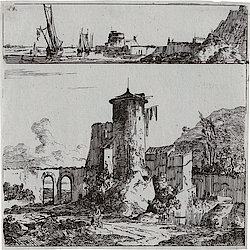Loading the page ...
Louis-Gabriel Moreau
(known as “the Elder”, 1739–1805, Paris)
Marine; La Tour ronde, au linge étendu; Le Semaphore; L'Écriteau; La Maison au bord de la rivière. Five etchings on two plates, printed on pale green laid paper. Each approx. 11.7 x 16.2 cm and 11.4 x 16 cm. After 1779. Wildenstein 17-18; Prouté 18-21.
The landscape painter, Louis-Gabriel Moreau, was the elder brother of Jean-Michel Moreau the Younger (1741–1814). Moreau l’Ainé, who studied under the architectural painter, Pierre de Machy, first became publicly known through the drawings of ruins he exhibited at the Salon de la Jeunesse in 1760. He was made a member of the Accademia di San Luca in 1764. Moreau’s preferred landscape motifs were from the Île de France, which he reproduced in watercolour and gouache. The artist was never made a member of the Paris Academy and his work attracted little attention during his lifetime. It was not until the mid-20th century that an interest arose in his oeuvre, the modest, timeless realism of which extends beyond the Rococo period.
The small prints on offer here are remarkable for the freshness and immediacy of their observation of nature. Louis-Gabriel Moreau the Elder produced a corpus of sixty-nine prints, mostly small etchings, the majority of which are depictions of picturesque, enchanted gardens and pastoral landscape motifs. Staffage figures rarely appear, although discarded work utensils hint at some human presence. The landscape impressions are the product of a straightforward, spontaneous etching technique, the subtlety of which is only apparent at second glance. The delicate, atmospheric distribution of light is achieved by a sophisticated harmony between the etched lineament and the masterful utilisation of the blank paper tone. Moreau is now regarded as one of the foremost representatives of eau-forte libre in 18th century French art. As is the case with the two sheets on offer here, the earliest prints of his etchings are printed on pale green laid paper and probably date to a little after 1779. These extremely rare impressions are before the number and before the addition of a second framing line as well as before the later impressions on white paper of the edition edited by F.-E. Joubert (see exhibition catalogue Regency to Empire. French Printmaking 1715–1814, Baltimore-Boston-Minneapolis 1984-85, pp. 234-35, no. 79 a-d). Very fine, crisp impressions with thread margins around the framing line. Minor handling traces, otherwise in impeccable condition.
Contact us for further information

